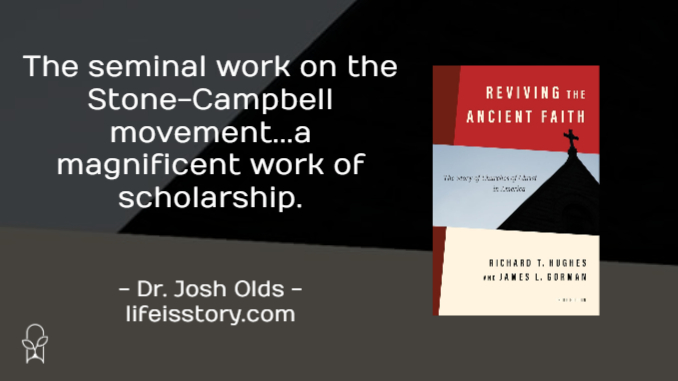
Published by Eerdmans on January 11, 2024
Genres: Academic, Non-Fiction, Biography
Buy on Amazon
Goodreads

A balanced, well-documented history of the Churches of Christ in America The Churches of Christ is a denomination defined by not being a denomination. These communities intended to restore a primitive Christianity, undivided by historical quarrels. Despite this ideal, the Churches of Christ in America have a surprisingly complex history dating back to the nineteenth century. James L. Gorman’s fresh edition of Richard T. Hughes’s classic work, Reviving the Ancient Faith , illuminates the movement started by Barton Stone and Alexander Campbell. The authors trace the movement’s sociological transformation into a denomination from the 1830s into the twentieth century. Four developments forged this new the premillennialist controversy, the divide over institutions, the racial segregation of congregations and schools, and the fight over liberalism in the 1960s. New to the third edition, the final chapters bring the history of Churches of Christ from the 1960s up to 2022, analyzing the growing diversity of the movement amid intradenominational “culture wars.” Reviving the Ancient Faith , 3rd edition, challenges readers to learn the historical basis of Church of Christ identity and beliefs. Students of the history of the Church of Christ and American religion will derive from its pages a more holistic and informed understanding of the tradition.
I grew up in the Church of Christ, but never really got into its history. The independent nature of the denomination (to the point some still wince at it being called that) means that the history of the church and its theological background was never really at the forefront of church life. But that history and background still existed and serves as an important factor in understanding the Churches of Christ today. Reviving the Ancient Faith: The Story of Church of Christ in America is written by historians Richard Hughes and James Gorman, both of whom work for Christian universities coming from the Church of Christ tradition.
This is an updated third edition of Hughes’s original 1996 work, also published by Eerdmans. Hughes is now in his 80s serving as scholar-in-residence at Lipscomb University and turned to James Gorman to update and rework the text. The end goal of this edition was to update the scholarship, add a section to discuss the Churches of Christ in the 21st century, and reduce the overall word count. Even with such a reduced wordcount, Reviving the Ancient Faith still weighs in at over 450 pages.
The book is divided into three sections. The first section covers the formation of the Churches of Christ as a sect and the leaders’ resistance to being called a denomination. The early leaders of the CoC saw their movement as a restoration of the church away from denominationalism to the “true” church. The movement, called the Restoration Movement, swept through the Midwest in the 1800s through the person of Alexander Campbell and the rise of apocalyptism.
The second part of the book details how the sect morphed into a denomination and began to establish itself in the first part of the twentieth century. Hughes and Gorman include a very interesting discussion on the creation and segregation of Black Churches of Christ and how, because of racist ideology within the church, historically Black CoCs created their own culture separate from the mainstream (read: white) CoC movement. Hughes and Gorman discuss all the major players in the movement, how the theological foundations shifted at this time, and how all that led to fragmentation.
The third part of Reviving the Ancient Faith covers the latter part of the twentieth century into the present and, honestly, this could be volumes in and of itself. The churches of Christ would eventually fragment into disparate denominations: the Churches of Christ, the Christian Church, and the Christian Church (Disciples of Christ). And there was friction between all of these churches. I can recall my childhood church, ___________ Church of Christ, appending “Christian Church” to its title so as not to be confused with the Church of Christ church in the town. The Disciples of Christ represented a more liberal wing of the breakup, something my parents were not aware of until we attended a DoC church on vacation once to find (to our horror) a woman preaching.
That liberal movement within the Church of Christ—not just the Disciples offshoot—is a compelling and interesting addition to the book. Gorman and Hughes tackle the history of the denomination’s views on women in ministry, homosexuality, and other cultural and religious issues that have fractured denominations.
Reviving the Ancient Faith is objective and comprehensive. The authors write in the introduction that, while they have affinities for and affiliations with the Church of Christ, they are historians foremost and they did not shy away from when the history of their denomination (or its present) is less than palatable. I appreciated their straightforwardness and ability to not lionize either the denomination’s present or past.
Reviving the Ancient Faith is an incredible work of scholarship, probably the seminal work on the Stone-Campbell movement, and should be a stalwart of church history classes, particularly within Church of Christ affiliated universities and Bible colleges. For me, it was a great look into the history of my religious foundation—even if that’s no longer a denomination I am affiliated with. Interestingly for me, Hughes would later serve within Anabaptist circles and write heavily on racial justice and pacificism, so I guess maybe there’s a Church of Christ to Anabaptist pipeline I got on somehow. In any case, this was a deep read that I very much enjoyed.
